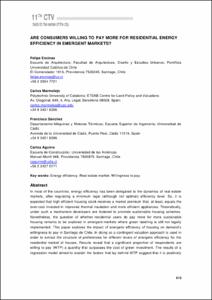Mostra el registre d'ítem simple
Are consumers willing to pay more for residential energy efficiency in emergent markets?
| dc.contributor.author | Encinas, Felipe |
| dc.contributor.author | Marmolejo Duarte, Carlos Ramiro |
| dc.contributor.author | Sánchez, Francisco |
| dc.contributor.author | Aguirre, Carlos |
| dc.date.accessioned | 2016-10-24T15:47:13Z |
| dc.date.available | 2016-10-24T15:47:13Z |
| dc.date.issued | 2016-07 |
| dc.identifier.citation | Encinas, Felipe [et al.]. Are consumers willing to pay more for residential energy efficiency in emergent markets?. A: Virtual City and Territory. "Back to the Sense of the City: International Monograph Book". Barcelona: Centre de Política de Sòl i Valoracions, 2016, p. 813-825. |
| dc.identifier.isbn | 978-84-8157-660-3 |
| dc.identifier.uri | http://hdl.handle.net/2117/91016 |
| dc.description.abstract | In most of the countries, energy efficiency has been delegated to the dynamics of real estate markets, after regulating a minimum legal (although not optimal) efficiency level. So, it is expected that high efficient housing stock receives a market premium that, at least, equals the over-cost invested in improved thermal insulation and more efficient appliances. Theoretically, under such a mechanism developers are fostered to promote sustainable housing schemes. Nonetheless, the question of whether residential users do pay more for more sustainable housing remains to be explored in emergent markets where green labelling is still not legally implemented. This paper explores the impact of energetic efficiency of housing on demand’s willingness to pay in Santiago de Chile. In doing so a contingent valuation approach is used in order to extract the structure of preferences for different levels of energetic efficiency for the residential market of houses. Results reveal that a significant proportion of respondents are willing to pay (WTP) a quantity that surpasses the cost of green investment. The results of a regression model aimed to explain the factors that lay behind WTP suggest that it is positively influenced by: income level (indirectly measured by the price range of the requested house), educational level and demographics, being households with small children who pay the most. These results have important implications on the design of public policies aimed to improve the energetic efficiency of new housing developments. |
| dc.format.extent | 13 p. |
| dc.language.iso | eng |
| dc.publisher | Centre de Política de Sòl i Valoracions |
| dc.relation.ispartof | International Conference Virtual City and Territory (11è: 2016: Cracòvia) |
| dc.rights | Attribution-NonCommercial-NoDerivs 3.0 Spain |
| dc.rights.uri | http://creativecommons.org/licenses/by-nc-nd/3.0/es/ |
| dc.subject | Àrees temàtiques de la UPC::Urbanisme |
| dc.subject.lcsh | Real property -- Valuation -- Chile |
| dc.subject.lcsh | Buildings -- Energy conservation -- Chile |
| dc.subject.other | Energy efficiency |
| dc.subject.other | Real estate market |
| dc.subject.other | Willingness to pay |
| dc.title | Are consumers willing to pay more for residential energy efficiency in emergent markets? |
| dc.type | Conference report |
| dc.subject.lemac | Béns immobles -- Valoració -- Xile |
| dc.subject.lemac | Edificis -- Estalvi d'energia -- Xile |
| dc.identifier.doi | 10.5821/ctv.8131 |
| dc.rights.access | Open Access |
| local.citation.contributor | Virtual City and Territory |
| local.citation.pubplace | Barcelona |
| local.citation.publicationName | Back to the Sense of the City: International Monograph Book |
| local.citation.startingPage | 813 |
| local.citation.endingPage | 825 |
Fitxers d'aquest items
Aquest ítem apareix a les col·leccions següents
-
11th Congress Virtual City and Territory, Krakow, 6-8 July 2016 [121]
Back to the sense of the city


